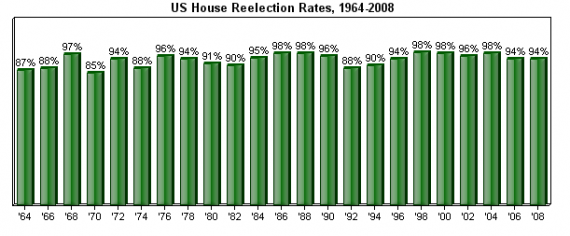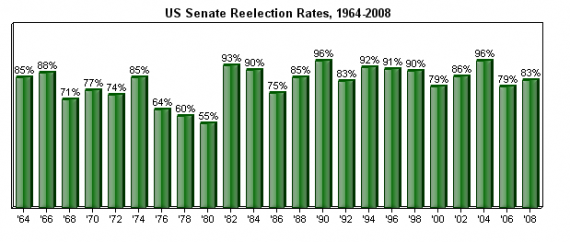Incumbent Re-Election Rates In The 2010 Mid-Terms
Back in June, I wrote about the 2010 elections and made this observation:
If history is any guide, then it seems very likely that we’ll see something in the range of 90-94% of the incumbents in the House of Representatives who are up for election win their races. As 1994 demonstrates, of course, this still means that there could be a change in party control, but a change in party control is not the same thing as a change in personnel. In the Senate, on the other hand, a change of, say, six seats would drop of the incumbent re-election rate to 81%, but would not give the Republicans control of the Senate. To do that, they’d need to pick up 11 10 seats, which seems incredibly unlikely.
Given all the natural advantages they have, I think it’s fairly clear that most incumbents in Congress will survive this wave of anti-incumbency just like they’ve survived all the others.
It turns out that I was off, but not by much.
In the House of Representatives, 87% of the incumbents who stood for election were re-elected. This is slightly below the historical trend over the last several decades, and lower than the re-election rate in 1994, 2006, and 2008:
 In the Senate, and assuming Lisa Murkowski’s write-in bid is successful, 84% of the incumbents who stood for re-election were successful (the number drops to 80%). Again, this is fairly consistent with the historical rate over the past forty years or so:
In the Senate, and assuming Lisa Murkowski’s write-in bid is successful, 84% of the incumbents who stood for re-election were successful (the number drops to 80%). Again, this is fairly consistent with the historical rate over the past forty years or so:
 So, despite the changes that many are calling “historic,” the fact of the matter is that incumbents were, for the most part, as safe in 2010 as they have been in previous elections.
So, despite the changes that many are calling “historic,” the fact of the matter is that incumbents were, for the most part, as safe in 2010 as they have been in previous elections.
Update: A commenter brings up the issue of incumbent retirements so I went and took a look at the numbers:
- There were 15 open Senate seats (8 Democratic, 7 Republican). Of those 4 flipped to the opposing party, all of those were seats formerly held by a Democrat being won by a Republican. That gives us a party open seat retention rate of 73% in the Senate
- There were 45 open House seats (24 Democratic, 21 Republican). Of those, 16 flipped to the opposing party, all but one of those (Delaware-At Large) were Democratic seats that went Republican. that gives us a retention rate of 64%

Looking over your chart, it would appear that the House saw the lowest incumbent re-election rate since 1970. Considering how much more gerrymandering affects the competitiveness of districts nowadays, I’d say you understate the significance of the shift. Raw numbers rarely tell the whole story.
Given that a majority of the districts that flipped were purple districts that had been picked up in 2006 and 2008, I don’t think is quite as tectonic shift as you’re thinking.
It’s historic, all right, but if we have to go back to the Nixon Administration to find a comparable number then I think that’s a sign that far too many districts have been “safe” for far too long.
But you did not account for the large number of Dems that retired before the bloodbath.
The whole post is invalid sans that data.
L.A. dude,
The phrase “incumbents who stood for re-election” answers that question, does it not ?
I will address the retirement issue in a post update that I will put up shortly
Why not just say straight out that “anti-incumbent wave” is over the top rhetoric? Let the myth die.
I don’t know who framed the election is anti incumbent in the first place. Was that what we were looking for from the election? I was looking at if the Republicans were going to get the Senate or not and how many governorships they would pick up. Factor in retirees and governors into these numbers and I’m sure we’re looking at something that only has happened a handful of times before.
In Texas the Republicans have the most seats in 141 years or something. Russ Fiengold was tossed in WI, and the other commenter is correct; many saw the writing on the wall and retired.
I absolutely love the Dems……
If we quit because we knew we would get an a$$ kicking, it soen’t count…..
If blah, blah blah, then we didn’t really lose……..
The left doesn’t really know who or what to punch at, all they know is they got an honest to goodness old fashioned bute kicking on the house.
If not for the lousy candidates in the senate races, we would have that too. But hey, we’ll have it in 2012.
FUZZY MATH??????
2010 was an “anti-incumbent year” mostly insofar as a lot of the incumbents were Democrats and it was a Republican year. There were an unusual number of primary losses, it seems like, but that happens so rarely that a couple of oddities can look like huge shifts.
Regarding the senate votes, one of the big reasons that incumbents did so well is that the less popular party had rather few seats to defend. The Democrats were extraordinarily lucky in this regard. If they had to defend their 2012 seats, including those that got in on the wave of 2006, you likely would have seen significantly greater losses.
Who cares…
I don’t think that people will live better if the head of the country will be Democrats
Given the years you cite (1964-2010), how atypical was this election? How many standard deviations away from the mean was it? That is the rational and sensible way to analyze the results. Anything else is just empty posturing.